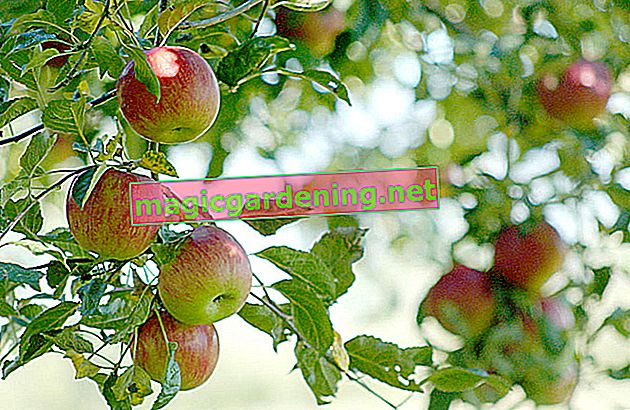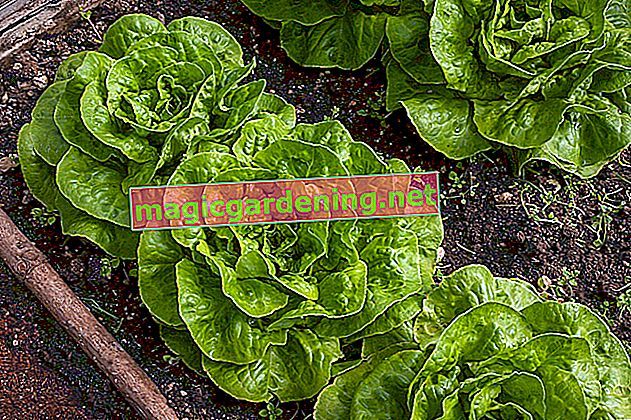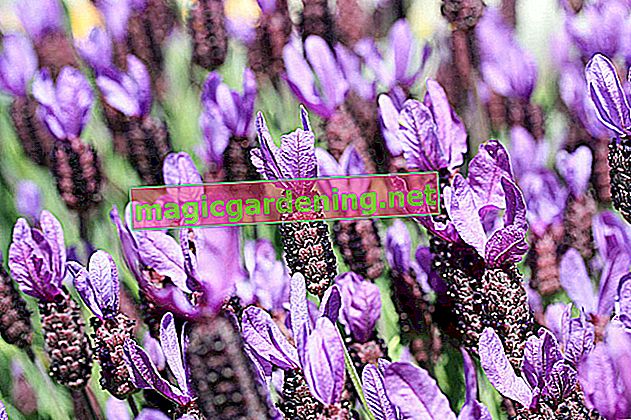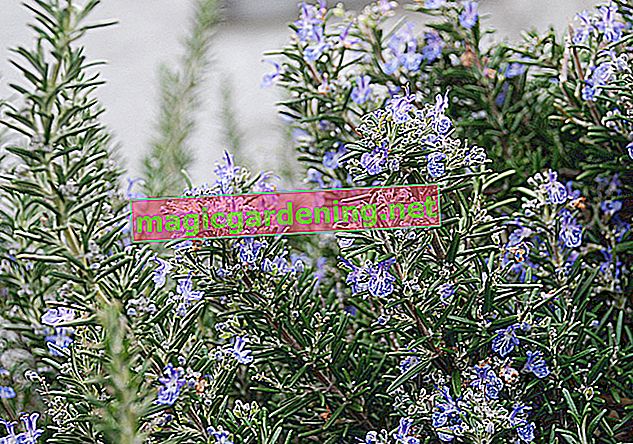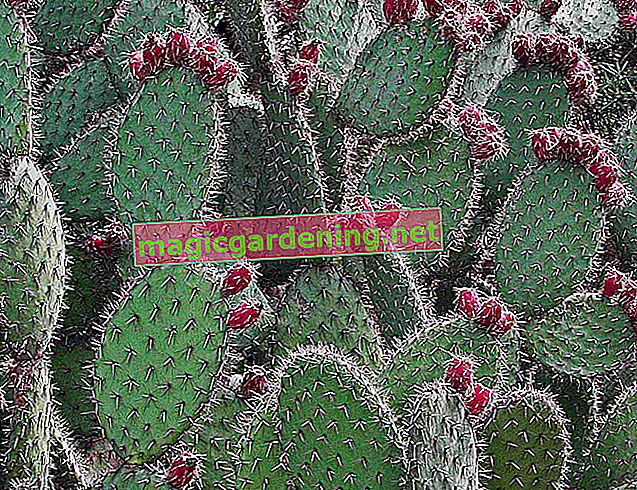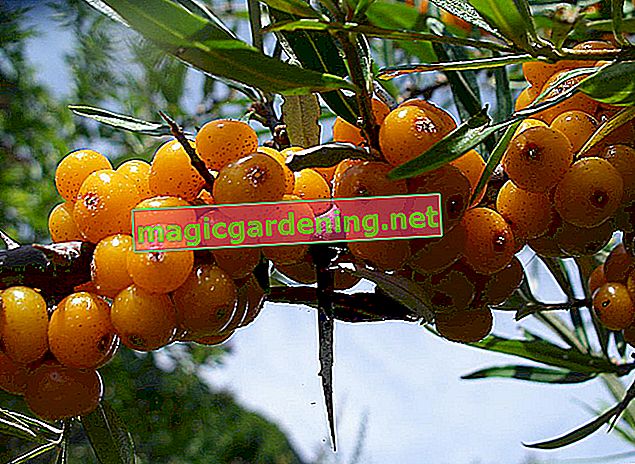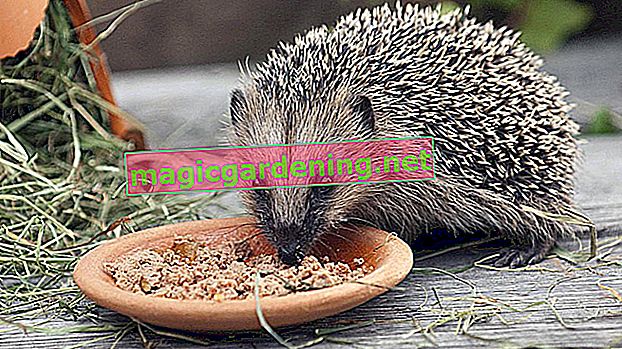
the essentials in brief
- Year-round feeding has advantages and disadvantages; It is especially useful to feed in autumn and winter when feed is scarce
- Hedgehogs mainly eat insects such as worms, snails and beetles, but also fruit and vegetables when meat-containing food is scarce
- Hedgehogs can be fed cat or dog food, scrambled eggs, or oatmeal; Fried fish or meat without spices can also be given
Feeding hedgehogs in summer and winter?
Shrinking habitats, insect deaths and climate change do not leave wildlife without a trace. More and more garden owners are setting up feeding stations to compensate for the lack of food for hedgehogs and other insectivores. From the point of view of the experts, this measure is good and correct as long as the support is limited to a clearly defined period. However, there are downsides to consider. The following table summarizes the advantages and disadvantages of year-round feeding for hedgehogs:
also read
- This is how hedgehogs overwinter in your garden - tips for the right winter quarters
- Why, when and how do hedgehogs hibernate?
- Feeding Squirrels - All You Need To Know
| advantages | disadvantage |
|---|---|
| Compensate for lack of food | Food envy and social stress |
| Cope with the effects of drought | Source of infection feeding point |
| Cushion habitat loss | poor feed quality |
| Prevent weakening of the immune system due to lack of food | inbreeding |
| Mating battles | |
| Loss of natural independence | |
| Obesity |
Explanation of the benefits
Insect mortality and the decline in species can no longer be denied. Climate change is aggravating with long-lasting heat and dust-dry soil. The already stagnant flock of insects and molluscs often crawls deep into the ground in summer, inaccessible to starving hedgehogs. In order to get full, the insectivores have to walk a long way. Shrinking habitats, fragmented by streets, functional gardens as gravel heaps and insurmountable concrete walls make life difficult for hungry hedgehogs. The resulting malnutrition massively weakens the immune system, so diseases and parasites have an easy time of it. From this point of view, the establishment of feeding places makes sense.
Explanation of the disadvantages
Hedgehogs are by nature loners who respectfully avoid each other. A meeting is unavoidable at feeding places. Social stress and food envy create an aggressive climate that leads to real boxing matches. Weakened hedgehogs, who are particularly dependent on additional feed, lose out. Hedgehogs poop where they are. This makes every hedgehog feeding place a dangerous source of infection, even with daily cleaning. Pathogenic pathogens are simply passed on in close proximity to each other on the food bowl.
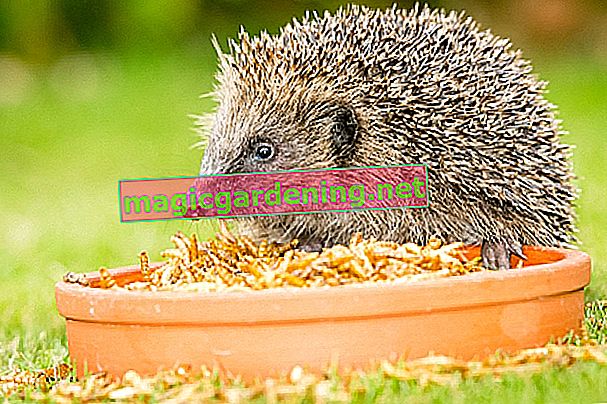
The greatest disadvantage of feeding hedgehogs is poor feed quality combined with a lack of knowledge about appropriate feed. Cat food from the discounter or dry hedgehog food as a complete feed are typical mistakes that, from a nutritional point of view, do more harm than good to hedgehogs. But even with high-quality ingredients, year-round feeding for hedgehogs ultimately leads to nutrient deficiency, diarrhea, loss of stings and tartar.
If the richly laid table is within reach, male hedgehogs no longer go to regions further away to look for a bride. Inbreeding and bloody mating battles are the consequences. In addition, fed hedgehogs become disastrously dependent on humans at the expense of natural instincts. The fateful result of year-round feeding is, not least, being very overweight because hedgehogs are insatiable.
Temporary feeding is desirable
For hedgehogs in need, short-term feeding is the last resort. You can avoid the explained problems of year-round feeding if you help hedgehogs with a temporary feeding station under the following conditions:
- in autumn : before hibernation, young hedgehogs often do not have sufficient fat reserves
- in winter : hedgehogs awakened from hibernation are threatened with starvation
- in spring : after hibernation, as long as it freezes and no insects are around
- in summer : found, injured or sick hedgehogs for 1-2 days
If underweight hedgehogs have built up sufficient fat reserves and there are enough insects on the way again, feeding should be stopped. An exception applies to hedgehogs found, sick or injured. Affected animals should be taken care of by the veterinarian or the hedgehog care station as soon as possible. Any waiting times of one or two days until delivery are bridged with additional feed.
background
Hedgehog-friendly garden
Hedgehog-friendly garden alleviates food shortages and housing shortages. Meticulously tidy gardens not only cause food shortages, but also rarely have winter quarters to offer. With a hedgehog-friendly garden, you solve both problems at once. Benjamin hedges, piles of leaves, dry stone walls with cavities or even a cat-safe hedgehog house are perfect for a safe, cozy retreat. In order for hedgehogs to make rich prey in the garden, flowers, perennials and local flowering trees should dominate the planting plan, which attract flocks of insects.What does a hedgehog usually eat?
Hedgehogs are primarily insect eaters, but they also do not disdain worms, beetles and snails. Earwigs and millipedes are also high on the menu. During lean, insect-free times, the sting knights also enjoy a good taste of carrion to meet their daily needs for calories, proteins and vitamins.
It belongs in the land of fables that hedgehogs eat a vegetarian diet. Carnivores are only interested in fruit or vegetables when juicy maggots or caterpillars cavort in them. When it is hot, the clever survivors cover their water needs with berries or windfalls. Their particular preference for sweets occasionally tempts those with a sweet tooth to nibble on ripe apples or bananas. The digestive system is not designed for processing vegetarian food, so that the small sins are excreted almost undigested.
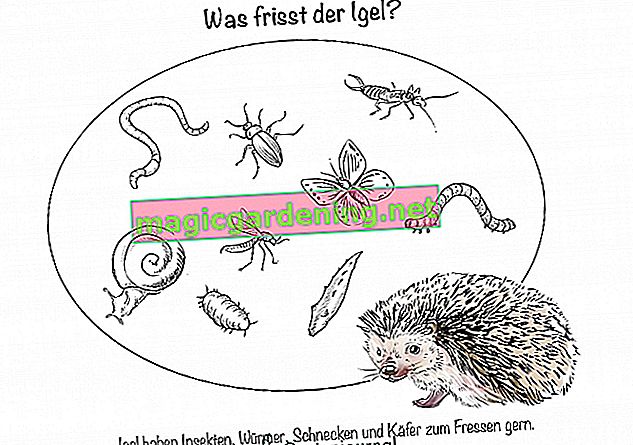
Caption: Hedgehogs like to eat insects, worms, snails and beetles.
What can I feed hedgehogs?
It is not an easy undertaking to feed hedgehogs in a species-appropriate manner. No substitute food, no matter how expensive, comes close to the high quality of natural feed sources. A suitable complete feed for hedgehogs has yet to be invented. You can buy dry hedgehog food in specialist shops, which is only an ingredient due to its high carbohydrate content. A balanced mixture of different components is primarily suitable as a tried and tested bridging of acute nutritional deficits. The following table compares permitted and prohibited foods for hedgehogs:
| allowed | forbidden |
|---|---|
| Hedgehog dry food | milk and milkproducts |
| cat food | cheese |
| Dog food without sauce | Nuts, peanuts |
| oatmeal | Raisins |
| Wheat bran | Apple, pear, banana |
| Eggs (cooked), scrambled eggs | raw eggs |
| unseasoned, fried meat | seasoned, raw meat |
| unseasoned, cooked fish | seasoned, raw fish |
| Mealworms | Lettuce, tomatoes, carrots, potatoes |
Please serve hedgehog food in a shallow bowl. Fresh, still water, which you put in a smaller bowl at the feeding place and exchange daily, is essential. The best time for feeding is during the evening twilight, when hedgehogs are already looking for food.
YoutubeRecipes for tasty hedgehog menus
Prickly eaters in the garden love a varied menu. The following recipes make little hedgehogs' hearts beat faster:
- Mix 100 g cat food with 2 tablespoons of dry hedgehog food
- Chop 100 g of poultry meat, mix with 2 tablespoons of oatmeal, fry in 1 teaspoon of vegetable oil
- Fry 30 g ground beef and 1 beaten egg in 1 teaspoon oil, stir in 2 tablespoons oat flakes
- Fry 60 g unseasoned minced meat in 1 teaspoon oil, add 1 tablespoon wheat bran
- Fry 60 g scrambled eggs with 1 teaspoon oil, stir in 2 tablespoons of dry hedgehog food
Digression
Baby hedgehog
Baby hedgehogs belong in the hands of experts. Orphaned young hedgehogs with closed eyes and ears found outside the nest have lost their mother. Lay people are overwhelmed when it comes to rescuing the helpless foundlings. Feeding baby hedgehogs requires special knowledge that goes far beyond the normal feeding of adult hedgehogs. Bring baby hedgehogs to the nearest hedgehog ward or a veterinarian as soon as possible. For safe transport, pad a cardboard box with torn newspaper or kitchen paper. It is important to note that you note the location and time of discovery as important information for the experts.Weigh the amount of feed
After it has been clarified what you are feeding hedgehogs with in a species-appropriate manner, the question of the correct amount of feed arises. The cute spiny animals are insatiable and don't know how to feel full. So that the additional feeding does not lead to excess weight, which is harmful to health, please weigh the daily ration carefully. The exact amount depends on the age and size of the invited guests. The following overview summarizes proven empirical values:
- Young hedgehogs : 120 to 150 grams per day
- Adult hedgehogs : 200 to 230 grams per day
When you stop feeding will determine the weight of your prickly fosterling. When young hedgehogs have fed each other 600 grams and adult hedgehogs a full 1,000 grams, it is time to put an end to the table. With this fighting weight, the spiked bearers are ideally equipped for independent foraging and an undamaged hibernation. Please do not clear the feeding station abruptly. Weaning is gentler by reducing the amount of feed by a third every day.
Tips
When hedgehogs wake up from hibernation, they haven't eaten anything for a long time. In the first three days, it is strongly advised to gradually increase the amount of food. If the starved insectivores feed the normal daily ration of 180 to 200 grams right from the start, considerable stomach and intestinal problems due to overload are inevitable.
Tips for the ideal feeding place
A properly arranged feeding place is not accessible to uninvited guests, such as cats, dogs, martens or foxes. Meticulous cleanliness prevents the spread of diseases, parasites, mold and rot. The following tips may inspire you to set up the perfect feeding place for hedgehogs:
- Best location: a protected, hidden place in the garden
- Ideally as a bird feeder made from a wooden box or assembled bricks
- Base area about 30x30x30 cm with an entrance hole 10x10x10 cm
- Roof weighed down with stones
- Floor secured against attacks from below with wire mesh
Hedgehogs often poop where they eat. If the feeding place is above open garden soil or lawn, please move the superstructure from time to time. A location on a sealed surface should be cleaned regularly. Hedgehogs do not eat where they sleep and vice versa. It is advantageous if the feed house and sleeping area, especially the winter quarters, are in the immediate vicinity. In the best case, both entrances are next to or opposite one another.
View this post on InstagramAutumn is officially ushered in 🍂🍁🌾 _______________________________________________ # Igel #Autumn #Sunshine # IgelFüttern # SoSüß #Instaigel #Instacute #PicOfTheDay #Instaphoto #InstaAutumn #Green #Brown #Stachelig #Eingeigelt #KedgehogFutter #HedgehogOut #Hedgehfove #HedgehogObst #Hedgehfove
A post shared by ➺ 𝑴𝒆𝒍𝒍𝒊 (@ _wife.life._) on Sep 21, 2015 at 12:48 pm PDT
Special case: feeding the young hedgehogs
Baby hedgehogs and very weak hedgehogs are unable to eat solid food on their own. In order to bridge a possible waiting time before being admitted to a hedgehog station, feed your little one by hand. This can be done using a pipette or disposable syringe without a needle.
Puppy replacement milk, which is available from the vet, is ideal as a liquid food. For a while, low-lactose cat milk from specialist shops or Hipp meat preparation (imprint: from the 4th month) pureed is suitable. Take the hedgehog lying on its back in your hand so that it assumes a slightly sitting position. Use your thumb to carefully stabilize your posture. Drip the liquid food four to five times a day into the hedgehog's mouth at a dose of 10 to 30 milliliters each. Please wait after each drop until the hedgehog has swallowed.
A misunderstood love of animals must not lead to year-round feeding and reasonless wintering of hedgehogs in the basement.
frequently asked Questions
Hedgehogs are insectivores, aren't they? Recently I saw a hedgehog take an interest in windfalls.
Hedgehogs mainly feed on insects, worms, beetles, snails, etc. However, they cannot resist a sweet snack in between, such as a fully ripe berry or a piece of apple. However, the digestive system of the insectivore is not geared towards the utilization of plant-based food, so that fruit is excreted almost undigested. If a hedgehog is interested in windfalls, it usually has the maggots it contains in its sights.
Should I help hedgehogs with additional feed in case of drought?
Many years of experience in hedgehog centers and hedgehog care stations have shown that the feeding of hedgehogs should be prohibited from spring to autumn. It is a old wives' tale that insectivores cannot find any food in summer drought and heat. Substitute feed of any kind never reaches the quality of natural prey animals. Feeding hedgehogs is only necessary in exceptional situations, such as early onset of winter or in late winter when there are no feed animals in nature.
When does a hedgehog hibernate?
In normal weather conditions, hedgehogs hibernate from November to the end of March / beginning of April. Females usually go into hibernation a month later because, after the exhausting rearing of their young, they need more time to build up sufficient fat reserves. In both sexes, the duration of the winter rest phase is about the same. This means that female hedgehogs wake up later in spring than their male counterparts.
After hibernating, we made it easier for the hedgehogs in our garden to start the season with cat food. Can we continue to provide food in May? The whole family enjoys watching the hedgehogs feed in the evening.
Please stop feeding now. Understandably, it is a pleasure to watch cute hedgehogs feast. However, you are doing the insectivores a disservice. Cat food is only partially and temporarily suitable as hedgehog food. If a set table is ready every evening, hedgehogs no longer hunt insects, become fat, lazy and, in the worst case, sick. Feeding hedgehogs should only be a stopgap solution in order to bridge food-poor times in late winter.
Tips
The Naturschutzbund (NABU) underpins the urgency of species-appropriate protective measures for hedgehogs. As part of the citizen research project “Hedgehogs in Bavaria” it was shown that the destruction of habitats increasingly forces hedgehogs into the vicinity of human settlements. The sad result: of 28,000 hedgehogs counted in 2015, more than a third were dead, mostly sad victims in traffic.

